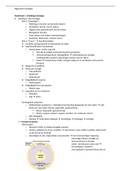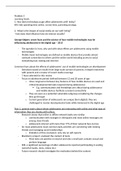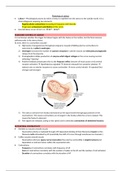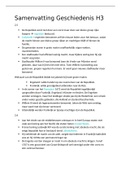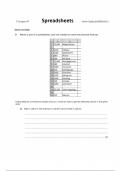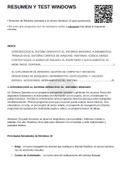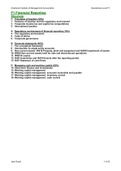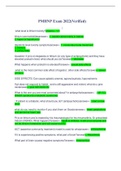Algemene fysiologie
Hoofdstuk 1: inleiding fysiologie
0. Inleiding in de fysiologie
- Wat is “fysiologie”?
o Werking en functie van levende materie
o Aristoteles: kennis van de natuur
o Hippocrates: geneeskracht van de natuur
o Biologische functies
o Gaat samen met andere wetenschappen
o Anatomie, biochemie, chemie, fysica
- Wat is “leven”? karakteristieken
1) Complex, georganiseerd en bestaande uit cellen
2) Gekenmerkt door homeostase
o Homeostase: verder nog info
Feit dat je relatief constante houdt in je lichaam
Lichaamstemperatuur: belangrijkste verbranding van energie,
voedingstoffen (andere oplossingen werken ook bv rillen)
Zweet temperatuur daalt: energie nodig om te verdampen (uit warmte
lichaam)
3) Reageren op prikkels
4) Nood aan energie
o Fotosynthese
o Autotroof
o Heterotroof
5) Mogelijkheid tot groei
o Wordt groter
6) Mogelijkheid tot reproductie
o Wordt meer
7) Capaciteit om te evolueren
o Mutaties
o Aap mens
- Fysiologische systemen
o Multicellulair organisme = individueel levend ding bestaande uit vele cellen veel
boven en veel onder (boven: populatie, gemeenschap
Boven: populatie, gemeenschap
Onder: orgaan systeem, orgaan, weefsel, cel, molecule, atoom
o Niet belangrijk
o Chemie moleculaire biologie cel biologie fysiologie ecologie
- Functie en proces
- Homeostase
o Waarom? Liefst zo stabiel mogelijk systeem
o Homeo: gelijkend & stase: condities homostase: exact zelfde condities altijd (36,8°
en bij 36,9 ga je al dood)
o Eencelligen in zee: altijd zelfde concentraties heel evenwichtige omgeving
Menselijk lichaam moeilijk om
homeostatisch te houden
cellen: membranen raken niet
intracellulaire vloeistof
extracellulaire vloeistof binnen de cel
,Algemene fysiologie
o Lokale controle: cellen in nabijheid van verandering leiden de respons in
o Reflex controle: cellen controleren op een verre plaats de respons
o Feedback mechanismen
Vissen voorbeeld
o Negatieve feedbackloop: de reactie werkt de stimulus tegen, waardoor de
reactiekring wordt afgesloten
,Algemene fysiologie
Hier: dat de watertemperatuur niet blijft stijgen
o Positieve alleen voorbeeld bevalling kennen hoort niet tot homeostase
De respons versterkt de stimulus, waardoor de variabele verder van het
instelpunt komt te liggen
Samenvatting homeostase
o Feedback mechanismen
o Negatieve feedbackloop
o Positieve feedback loop hoort niet tot
homeostase
o Feedforward mechanismen
- Het “physiome project”
- Belangrijkste concepten in fysiologie
- Wetenschap achter fysiologie
Hoofdstuk 2: moleculaire interacties
- Herhaling chemie
o Elektronen, protonen, neuronen
o Veel ionen in lichaam neuronenfysiologie
o Zenuwcellen werken op elektrochemisch niveau (stoten tegen iets, gevoel door heel
lichaam)
o Fosfaatgroep: belangrijk
Aan/uit knop proteïnen
o Zuurteregeling lichaam is ook homeostatisch (cellen kunnen niet tegen te zuur)
ademhaling (CO2)
o Polair/ niet polair belangrijk voor membraantransport
,Algemene fysiologie
Polair (suiker): lost goed op in water
Niet-polair (olie): lost niet goed op in water
o Ionbindingen: in water oplossen blijven ionen over
o NaCl Na+ - Cl –
- Biomoleculen
o Koolhydraten: glucose + sachariden -COOH
o Lipiden: minder zuurstof dan koolhydraten + niet-polair
Fosfolipiden= opbouw membraan
Hydrofiele kop = houdt van water
Hydrofobe staart
o Proteïnen: grote biomolecule bestaande uit meer dan 100 aminozuren
o Polypeptide: 10 – 100 aminozuren
o Aminozuren: COOH + NH2 + R
Primaire structuur
Secundaire: a-helix en beta
Tertiaire structuur
Quaternary structuur collageen, hemoglobine
o Waterstofbruggen, van der waals krachten, zwavelbindingen tertiaire structuur
o ATP: adenosine-trifosfaat
AMP + fosfaatgroep = ADP (energie nodig ATP wilt niet binden) oranje
ADP = minder stabiel dan AMP
ADP + fosfaatgroep = ATP (veel energie insteken om te binden) rood
Door veel energie er in te steken = energierijk molecule geworden
, Algemene fysiologie
o DNA & RNA
A & T RNA = A & U
G&C
- Waterige oplossingen, zuren, basen, buffers
o Oplosbaarheid, oplossingen, solventen
o Hydrofiel, hydrofoob lipide dubbellaag: hydrofobe staarten tegen elkaar,
hydrofiele koppen naar buiten
o Concentratie
Mol
Moleculaire massa
Hoofdstuk 1: inleiding fysiologie
0. Inleiding in de fysiologie
- Wat is “fysiologie”?
o Werking en functie van levende materie
o Aristoteles: kennis van de natuur
o Hippocrates: geneeskracht van de natuur
o Biologische functies
o Gaat samen met andere wetenschappen
o Anatomie, biochemie, chemie, fysica
- Wat is “leven”? karakteristieken
1) Complex, georganiseerd en bestaande uit cellen
2) Gekenmerkt door homeostase
o Homeostase: verder nog info
Feit dat je relatief constante houdt in je lichaam
Lichaamstemperatuur: belangrijkste verbranding van energie,
voedingstoffen (andere oplossingen werken ook bv rillen)
Zweet temperatuur daalt: energie nodig om te verdampen (uit warmte
lichaam)
3) Reageren op prikkels
4) Nood aan energie
o Fotosynthese
o Autotroof
o Heterotroof
5) Mogelijkheid tot groei
o Wordt groter
6) Mogelijkheid tot reproductie
o Wordt meer
7) Capaciteit om te evolueren
o Mutaties
o Aap mens
- Fysiologische systemen
o Multicellulair organisme = individueel levend ding bestaande uit vele cellen veel
boven en veel onder (boven: populatie, gemeenschap
Boven: populatie, gemeenschap
Onder: orgaan systeem, orgaan, weefsel, cel, molecule, atoom
o Niet belangrijk
o Chemie moleculaire biologie cel biologie fysiologie ecologie
- Functie en proces
- Homeostase
o Waarom? Liefst zo stabiel mogelijk systeem
o Homeo: gelijkend & stase: condities homostase: exact zelfde condities altijd (36,8°
en bij 36,9 ga je al dood)
o Eencelligen in zee: altijd zelfde concentraties heel evenwichtige omgeving
Menselijk lichaam moeilijk om
homeostatisch te houden
cellen: membranen raken niet
intracellulaire vloeistof
extracellulaire vloeistof binnen de cel
,Algemene fysiologie
o Lokale controle: cellen in nabijheid van verandering leiden de respons in
o Reflex controle: cellen controleren op een verre plaats de respons
o Feedback mechanismen
Vissen voorbeeld
o Negatieve feedbackloop: de reactie werkt de stimulus tegen, waardoor de
reactiekring wordt afgesloten
,Algemene fysiologie
Hier: dat de watertemperatuur niet blijft stijgen
o Positieve alleen voorbeeld bevalling kennen hoort niet tot homeostase
De respons versterkt de stimulus, waardoor de variabele verder van het
instelpunt komt te liggen
Samenvatting homeostase
o Feedback mechanismen
o Negatieve feedbackloop
o Positieve feedback loop hoort niet tot
homeostase
o Feedforward mechanismen
- Het “physiome project”
- Belangrijkste concepten in fysiologie
- Wetenschap achter fysiologie
Hoofdstuk 2: moleculaire interacties
- Herhaling chemie
o Elektronen, protonen, neuronen
o Veel ionen in lichaam neuronenfysiologie
o Zenuwcellen werken op elektrochemisch niveau (stoten tegen iets, gevoel door heel
lichaam)
o Fosfaatgroep: belangrijk
Aan/uit knop proteïnen
o Zuurteregeling lichaam is ook homeostatisch (cellen kunnen niet tegen te zuur)
ademhaling (CO2)
o Polair/ niet polair belangrijk voor membraantransport
,Algemene fysiologie
Polair (suiker): lost goed op in water
Niet-polair (olie): lost niet goed op in water
o Ionbindingen: in water oplossen blijven ionen over
o NaCl Na+ - Cl –
- Biomoleculen
o Koolhydraten: glucose + sachariden -COOH
o Lipiden: minder zuurstof dan koolhydraten + niet-polair
Fosfolipiden= opbouw membraan
Hydrofiele kop = houdt van water
Hydrofobe staart
o Proteïnen: grote biomolecule bestaande uit meer dan 100 aminozuren
o Polypeptide: 10 – 100 aminozuren
o Aminozuren: COOH + NH2 + R
Primaire structuur
Secundaire: a-helix en beta
Tertiaire structuur
Quaternary structuur collageen, hemoglobine
o Waterstofbruggen, van der waals krachten, zwavelbindingen tertiaire structuur
o ATP: adenosine-trifosfaat
AMP + fosfaatgroep = ADP (energie nodig ATP wilt niet binden) oranje
ADP = minder stabiel dan AMP
ADP + fosfaatgroep = ATP (veel energie insteken om te binden) rood
Door veel energie er in te steken = energierijk molecule geworden
, Algemene fysiologie
o DNA & RNA
A & T RNA = A & U
G&C
- Waterige oplossingen, zuren, basen, buffers
o Oplosbaarheid, oplossingen, solventen
o Hydrofiel, hydrofoob lipide dubbellaag: hydrofobe staarten tegen elkaar,
hydrofiele koppen naar buiten
o Concentratie
Mol
Moleculaire massa

